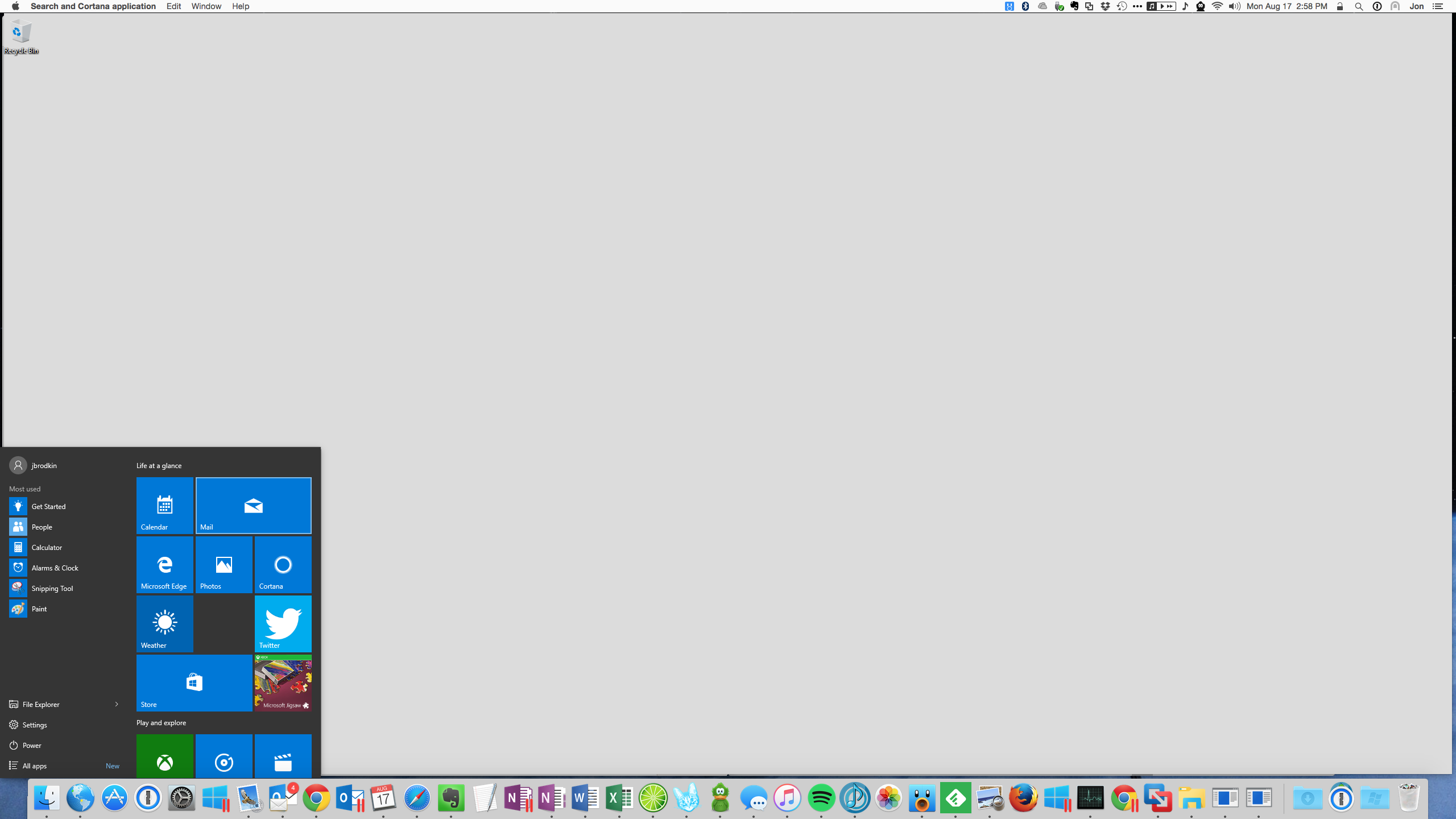Parallels Desktop 16 for Mac is the official version of Parallels for macOS users. The app is universal, meaning that it will work with both Intel and Apple Silicon-based Mac systems. When your Macbook pro gets stuck on grey screen, it actually becomes so dark and rather looks black. Due to Retina display on Mac, there is no power indicator on a Mac screen. When the system starts, your screen goes grey resulting in grey screen problem. It might have spinning gear, Apple logo, spinning globe etc.
Please take each of these steps that you haven't already tried. Some of them may not be applicable to your model or your situation. Stop when the problem is resolved.
To restart an unresponsive computer, press and hold the power button for a few seconds until the power shuts off, then release, wait a few more seconds, and press it again briefly.
Step 1
The first step in dealing with a startup failure is to secure the data. If you want to preserve the contents of the startup drive, and you don't already have at least one current backup, you must try to back up now, before you do anything else. It may or may not be possible. If you don't care about the data that has changed since the last backup, you can skip this step.
There are several ways to back up a Mac that is unable to start. You need an external hard drive to hold the backup data.
a. Start up from the Recovery partition, or from a local Time Machine backup volume (option key at startup.) When the OS X Utilities screen appears, launch Disk Utility and follow the instructions in this support article, under “Instructions for backing up to an external hard disk via Disk Utility.” The article refers to starting up from a DVD, but the procedure in Recovery mode is the same. You don't need a DVD if you're running OS X 10.7 or later.

b. If Step 1a fails because of disk errors, and no other Mac is available, then you may be able to salvage some of your files by copying them in the Finder. If you already have an external drive with OS X installed, start up from it. Otherwise, if you have Internet access, follow the instructions on this page to prepare the external drive and install OS X on it. You'll use the Recovery installer, rather than downloading it from the App Store.
c. If you have access to a working Mac, and both it and the non-working Mac have FireWire or Thunderbolt ports, start the non-working Mac in target disk mode. Use the working Mac to copy the data to another drive. This technique won't work with USB, Ethernet, Wi-Fi, or Bluetooth.
d. If the internal drive of the non-working Mac is user-replaceable, remove it and mount it in an external enclosure or drive dock. Use another Mac to copy the data.
Step 2
If you've started from an external drive, make sure that the internal startup volume is selected in the Startup Disk pane of System Preferences.
Start up in safe mode. Note: If FileVault is enabled in OS X 10.9 or earlier, or if a firmware password is set, or if the startup volume is a software RAID, you can’t do this. If you don't see the words 'Safe Boot' in the startup screen, you haven't started in safe mode. Ask for further instructions.
Safe mode is much slower to start and run than normal, and some things won’t work at all, including wireless networking on certain Macs.
The login screen appears even if you usually log in automatically. You must know the login password in order to log in. If you’ve forgotten the password, you will need to reset it before you begin.
If the startup progress bar gets stuck for more than a few minutes, or if the system shuts down automatically while the progress bar is displayed, the startup volume is corrupt and the drive is probably malfunctioning. In that case, go to Step 9. If you ever have another problem with the drive, replace it immediately.
If you can start and log in in safe mode, empty the Trash, and then open the Finder Info window on the startup volume ('Macintosh HD,' unless you gave it a different name.) Check that you have at least 9 GB of available space, as shown in the window. If you don't, copy as many files as necessary to another volume (not another folder on the same volume) and delete the originals. Deletion isn't complete until you empty the Trash again. Do this until the available space is more than 9 GB. Then restart as usual (i.e., not in safe mode.)
If the startup process hangs again, the problem is likely caused by third-party software that you installed. Ask for further instructions.
Step 3
If the startup process stops at a plain gray screen with a movable cursor, then the login dialog may be active but not visible because of a bug. You might be able to log in by using the arrow keys or the cursor to select the password field and typing your password as usual.
Step 4
If Step 3 fails, the startup volume may be full. If you had previously seen warnings of low disk space, this is almost certainly the case. You might be able to start up in safe mode even though you can't start up normally. Otherwise, start up from an external drive, or else use the technique in Step 1b, 1c, or 1d to mount the internal drive and delete some files. According to Apple documentation, you need at least 9 GB of available space on the startup volume (as shown in the Finder Info window) for normal operation.
Step 5

If a desktop Mac (without a built-in keyboard) hangs at a plain gray screen with a movable cursor, the keyboard may not be recognized. Press and hold the button on the side of an Apple wireless keyboard to make it discoverable. If need be, replace or recharge the batteries. If you're using a USB keyboard connected to a hub, connect it to a built-in port.
Step 6
Sometimes a startup failure can be resolved by resetting the NVRAM.
Step 7
If there's a built-in optical drive, a disc may be stuck in it. Follow these instructions to eject it.

Step 8
Press and hold the power button until the power shuts off. Disconnect all wired peripherals except those needed to start up, and remove all aftermarket expansion cards. Use a different keyboard and/or mouse, if those devices are wired. If you can start up now, one of the devices you disconnected, or a combination of them, is causing the problem. Finding out which one is a process of elimination.
Step 9
Launch Disk Utility in Recovery mode (see Step 1.) Select the startup volume, then run Repair Disk. If any problems are found, repeat until clear. If Disk Utility reports that the volume can't be repaired, the drive has malfunctioned and should be replaced. You might choose to tolerate one such malfunction in the life of the drive. In that case, erase the volume and restore from a backup. If the same thing ever happens again, replace the drive immediately.
This is one of the rare situations in which you should also run Repair Permissions, ignoring the false warnings it may produce. Look for the line 'Permissions repair complete' at the end of the output. Then restart as usual.
Step 10

If the startup device is an aftermarket SSD, it may need a firmware update and/or a forced 'garbage collection.' Instructions for doing this with a Crucial-branded SSD were posted here. Some of those instructions may apply to other brands of SSD, but you should check with the vendor's tech support.
Step 11
Reinstall the OS. If the Mac was upgraded from an older version of OS X, you’ll need the Apple ID and password you used to upgrade.
Step 12
Parallels For Mac Gray Screen Recorder
Do as in Step 11, but this time erase the startup volume in Disk Utility before installing. The system should automatically restart into the Setup Assistant. Follow the prompts to transfer the data from a Time Machine or other backup.
Step 13
This step applies only to models that have a logic-board ('PRAM') battery: all Mac Pro's, MacBooks with a removable main battery, and some others (not current models.) A dead logic-board battery can cause a startup failure. Typically the failure will be preceded by loss of the settings for the startup disk and system clock. See the user manual for replacement instructions. You may have to take the machine to a service provider to have the battery replaced.
Step 14
If you get this far, you're probably dealing with a hardware fault. Make a 'Genius' appointment at an Apple Store, or go to another authorized service provider.
Nov 9, 2015 12:14 PM
Try to start up from macOS Recovery
If your Mac seems to be turned on but nothing appears on your display, determine whether you're using a Mac with Apple silicon, then follow the appropriate steps:
Apple silicon
- Press and hold the power button for about 10 seconds.
- You should see the startup options window, which includes a gear icon labeled Options. Select Options, then click Continue.
- If you never see the startup options window, release the power button, then press and hold it again for another 10 seconds. If the issue persists, please contact Apple Support.
Intel processor
- Press and hold the power button for about 10 seconds.
- Press and release the power button, then immediately press and hold Command (⌘)-R until you see an Apple logo or other image.
- If you still see a blank screen after about 20 seconds, contact Apple Support.
Use Disk Utility to repair your startup disk
Parallels For Mac Gray Screen
If your Mac successfully started up from macOS Recovery, you should see a utilities window that includes Disk Utility. Use Disk Utility to repair your startup disk.
Parallels For Mac Gray Screen Download
If Disk Utility found no errors, reinstall macOS.
If Disk Utility found errors and repaired them, restart your Mac. If the issue returns after restarting, reinstall macOS.
Parallels For Mac Gray Screen Protector
If you still need help, please contact Apple Support.